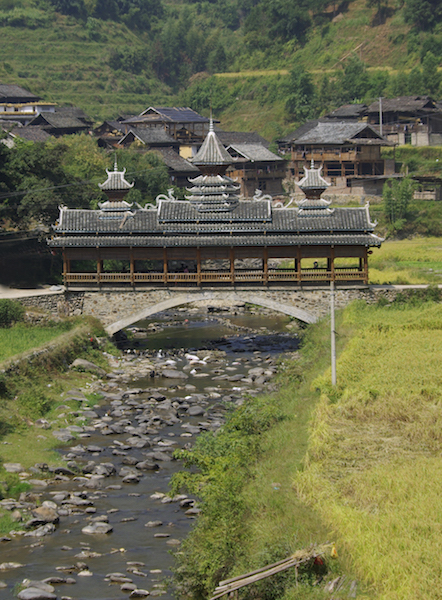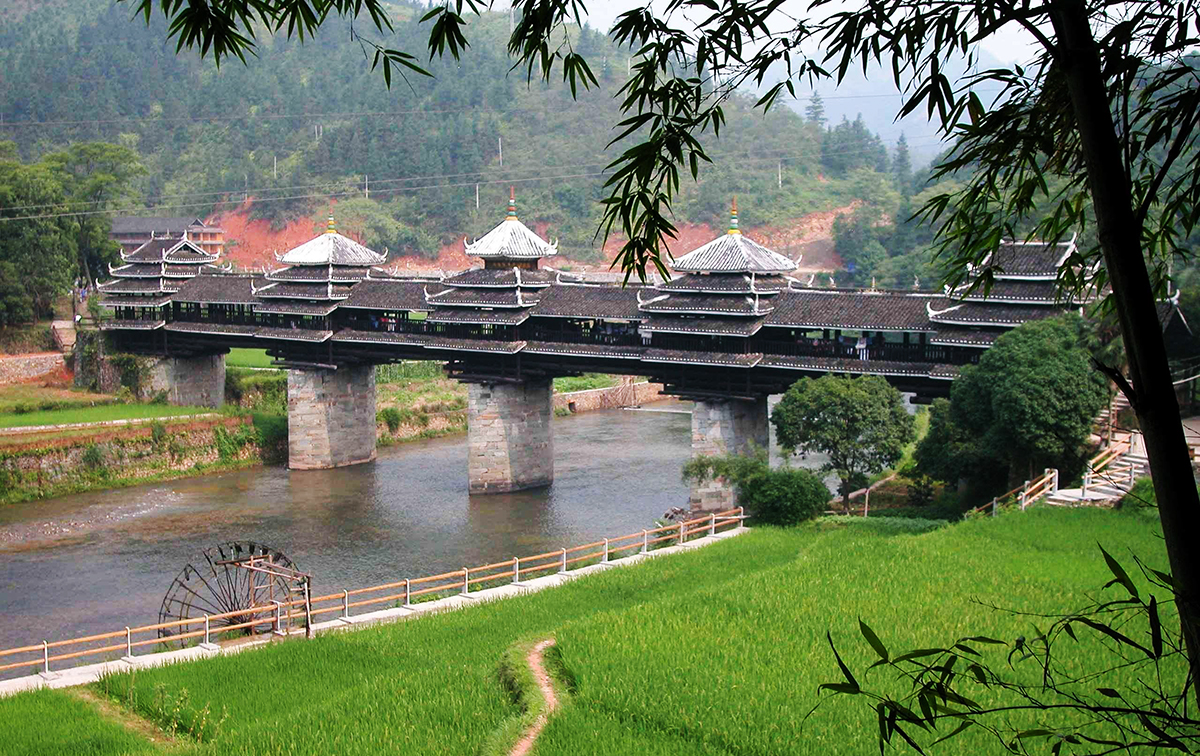
Wind-Rain bridges are so intricately carved and stunningly decorated that they look like small palaces that have been built atop a bridge. Along with the traditional Drum Towers, Wind-Rain bridges were developed by the Dong ethnic minority. They are a staple feature of any Dong village and provide the dual function of allowing members of the village to cross rivers and giving them a place to socialise. Not only are they striking to look at, Wind-Rain bridges are an architectural phenomenon in that no nails have been used to build them. They are a product of precise carpentry and local ingenuity.
Wind-Rain bridges are covered bridges that were originally designed to provide villagers with shelter from the wind and rain as they crossed the river, hence the name “Wind-Rain Bridge.” They are sometimes referred to as “Flower Bridges” due to the intricate carvings and paintings on the insides of their pavilions. Wind-Rain bridges are typically composed of a bridge, a tower and several pavilions, which are usually held up by stone or concrete piers. The roofs of these pavilions are usually quadrangular or hexagonal in shape and commonly have five-layers of eaves, although this can vary from region to region.
Wind-Rain bridges are predominantly made of wood and, instead of using nails, Dong carpenters use groove joints to fit the planks and columns of the bridge together perfectly. The towers, pavilions, stone piers and even the bridge itself will usually be adorned with beautiful carvings of dragons, phoenixes, cranes or other auspicious symbols. On both sides of the bridge, there are benches and railings so that locals can relax under the eaves. On a rainy day, it is not uncommon to see many local villagers gather under the bridge to socialise.
Chengyang Bridge

The most famous of these bridges is called Chengyang Bridge or Yongji Bridge in Sanjiang County, Guangxi. It was built in 1916 and is one of the four most famous bridges in China, in part due to its impressive size. It has two platforms (one at each end of the bridge), 3 piers, 3 spans, 5 pavilions, 19 verandas and three floors, and is about 65 metres long, 3 metres wide and 11 metres high, making it one of the largest Wind-Rain bridges in China. The eaves of the corridor are covered with lively paintings of mountains, lakes, flowers, birds and other natural scenes. Sitting on one of the many stools on the bridge, one can relax and enjoy a spectacular view of the Linxi River as it winds through the tea fields, past the lush green forests and below the bridge. However, peaceful though it may be, Chengyang Bridge is a popular tourist attraction in Guangxi and can be quite crowded.
If you want to visit a Wind-Rain bridge without the risk of crowds, we recommend visiting the Dong communities in Hunan and Guizhou province. There are plenty of bridges, of all different styles, in the Tongdao Dong Autonomous County in Hunan province, although these are slowly becoming more popularised as tourist sites. If you want a truly peaceful, culturally authentic experience, we strongly recommend the cluster of Dong villages in Congjiang County, Guizhou. These villages boast the largest variety of Wind-Rain bridges and have yet to become a popular tourist destination. Whether you’re in Guangxi, Hunan or Guizhou province, you can’t afford to miss these magnificent river palaces!
Join a tour with us to explore more about Wind-Rain Bridges: Explore the Culture of Ethnic Minorities in Guizhou